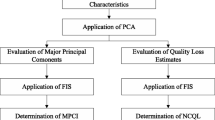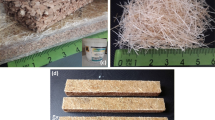Abstract
Among the various classifications of fiber-reinforced polymer composites, carbon fiber-reinforced plastic (CFRP) composite materials have great potential in aerospace, automobile and marine industries. Drilling is a common machining process of CFRP composites. Surface delamination, tearing, abrasion, denting, cutting of fibers, formation of voids, fiber bending and pullout, etc. are significant problems that occur in the drilling of CFRP composites, among which surface delamination is identified as a critical issue. By optimizing the drilling parameters, the effect of delamination can be minimized, resulting in good quality holes. The drilling process involves several critical process parameters. Therefore, achieving accurate holes during the process is extremely difficult. Three significant drilling process parameters were considered in the present investigation aimed at achieving an optimum drilling response: the thrust force and entry and exit delamination factors. An integrated response surface methodology-based particle swarm algorithm was used to obtain optimal drilling parameters. The obtained optimal settings for CFRP drilling are a drilling speed of 1100 rpm, a feed rate of 5 mm/rev, 5% CNTs and a 110° point angle. The high feed rate increases the thrust force and entry and exit delamination factors in the drilling of fabricated hybrid nano-CNT/CFRP composites.













Similar content being viewed by others
References
Turki Y, Habak M, Velasco R, Vantomme P (2017) Highlighting cutting mechanisms encountered in carbon/epoxy composite drilling using orthogonal cutting. Int J Adv Manuf Technol 92(1–4):685–697. https://doi.org/10.1007/s00170-017-0153-0
Fu R, Jia Z, Wang F, Jin Y, Sun D, Yang L, Cheng D (2018) Drill-exit temperature characteristics in drilling of UD and MD CFRP composites based on infrared thermography. Int J Mach Tools Manuf 135:24–37. https://doi.org/10.1016/j.ijmachtools.2018.08.002
Sorrentino L, Turchetta S, Bellini C (2018) A new method to reduce delaminations during drilling of FRP laminates by feed rate control. Compos Struct 186:154–164. https://doi.org/10.1016/j.compstruct.2017.12.005
Rajmohan T, Vinayagamoorthy R, Mohan K (2018) Review on effect machining parameters on performance of natural fibre–reinforced composites (NFRCs). J Thermoplast Compo Mater. https://doi.org/10.1177/0892705718796541
Qiu X, Li P, Li C, Niu Q, Chen A, Ouyang P, Ko TJ (2018) Study on chisel edge drilling behavior and step drill structure on delamination in drilling CFRP. Compos Struct 203:404–413. https://doi.org/10.1016/j.compstruct.2018.07.007
Harrag N, Refoufi A, Harrag A (2018) New NSGA-II-based OLSR self-organized routing protocol for mobile ad hoc networks. J Ambient Intell Humaniz Comput. https://doi.org/10.1007/s12652-018-0947-4
Shinko I, Kolici V, Obukata R, Barolli A, Oda T, Barolli L (2017) Performance analysis of a genetic algorithm based system for wireless mesh networks considering exponential and weibull distributions, DCF and EDCA, and different number of flows. J Ambient Intell Humaniz Comput 9(3):699–707. https://doi.org/10.1007/s12652-017-0468-6
Lei D, Zhang P, Zhang Y, Xia Y, Zhao S (2018) Research on optimization of multi stage yard crane scheduling based on genetic algorithm. J Ambient Intell Humaniz Comput. https://doi.org/10.1007/s12652-018-0918-9
Li N, Sheikh-Ahmad JY, El-Sinawi A, Krishnaraj V (2019) Multi-objective optimization of the trimming operation of CFRPs using sensor-fused neural networks and TOPSIS. Measurement 132:252–262. https://doi.org/10.1016/j.measurement.2018.09.057
Patra K, Jha AK, Szalay T, Ranjan J, Monostori L (2017) Artificial neural network based tool condition monitoring in micro mechanical peck drilling using thrust force signals. Precis Eng 48:279–291. https://doi.org/10.1016/j.precisioneng.2016.12.011
Chupakhin S, Kashaev N, Klusemann B, Huber N (2017) Artificial neural network for correction of effects of plasticity in equibiaxial residual stress profiles measured by hole drilling. J Strain Anal Eng Des 52(3):137–151. https://doi.org/10.1177/0309324717696400
Gautam GD, Pandey AK (2018) Teaching learning algorithm based optimization of kerf deviations in pulsed Nd:YAG laser cutting of Kevlar-29 composite laminates. Infrared Phys Technol 89:203–217. https://doi.org/10.1016/j.infrared.2017.12.017
Abhishek K, Rakesh Kumar V, Datta S, Mahapatra SS (2015) Parametric appraisal and optimization in machining of CFRP composites by using TLBO (teaching–learning based optimization algorithm). J Intell Manuf 28(8):1769–1785. https://doi.org/10.1007/s10845-015-1050-8
Kalita K, Bhoi PMA, Ghadai R (2018) Optimizing drilling induced delamination in gfrp composites using genetic algorithm and particle swarm optimisation. Adv Compos Lett 27(1):1
Ojeda GDR, de Almeida LAL, Vilcanqui OAC (2018) Parameter estimation of nonlinear thermoelectric structures using particle swarm optimization. Simul Model Pract Theory 81:1–10. https://doi.org/10.1016/j.simpat.2017.11.004
Kitayama S, Natsume S (2014) Multi-objective optimization of volume shrinkage and clamping force for plastic injection molding via sequential approximate optimization. Simul Model Pract Theory 48:35–44. https://doi.org/10.1016/j.simpat.2014.07.004
Liu L-L, Wan X, Gao Z, Li X, Feng B (2018) Research on modelling and optimization of hot rolling scheduling. J Ambient Intell Humaniz Comput. https://doi.org/10.1007/s12652-018-0944-7
Pinho LV, Carou D, Davim JP (2016) Delamination of carbon fiber reinforced plastics: analysis of the drilling method
Hocheng H, Chen CC, Tsao CC (2018) Prediction of critical thrust force for tubular composite in drilling-induced delamination by numerical and experimental analysis. Compos Struct 203:566–573. https://doi.org/10.1016/j.compstruct.2018.07.051
Voss R, Seeholzer L, Kuster F, Wegener K (2019) Analytical force model for orthogonal machining of unidirectional carbon fibre reinforced polymers (CFRP) as a function of the fibre orientation. J Mater Process Technol 263:440–469. https://doi.org/10.1016/j.jmatprotec.2018.08.001
Karpat Y, Bahtiyar O (2015) Tool geometry based prediction of critical thrust force while drilling carbon fiber reinforced polymers. Adv Manuf 3(4):300–308. https://doi.org/10.1007/s40436-015-0129-y
Abhishek K, Datta S, Mahapatra SS (2014) Optimization of thrust, torque, entry, and exist delamination factor during drilling of CFRP composites. Int J Adv Manuf Technol. https://doi.org/10.1007/s00170-014-6199-3
Kumar D, Sing KK (2017) Experimental analysis of delamination, thrust force and surface roughness on drilling of glass fibre reinforced polymer composites material using different drills. Mater Today Proc 4(8):7618–7627. https://doi.org/10.1016/j.matpr.2017.07.095
Samuel Raj D, Karunamoorthy L (2019) Performance of cryogenically treated WC drill using tool wear measurements on the cutting edge and hole surface topography when drilling CFRP. Int J Refract Metal Hard Mater 78:32–44. https://doi.org/10.1016/j.ijrmhm.2018.08.011
Shunmugesh K, Panneerselvam K (2018) Multi-performance optimization of drilling carbon fiber reinforced polymer using taguchi: membership function. Trans Indian Inst Met 71(7):1615–1627. https://doi.org/10.1007/s12666-018-1296-x
Heidary H, Karimi NZ, Minak G (2018) Investigation on delamination and flexural properties in drilling of carbon nanotube/polymer composites. Compos Struct 201:112–120. https://doi.org/10.1016/j.compstruct.2018.06.041
Rao S, Sethi A, Das AK, Mandal N, Kiran P, Ghosh R, Dixit A, Mandal A (2017) Fiber laser cutting of CFRP composites and process optimization through response surface methodology. Mater Manuf Processes 32(14):1612–1621
Rajmohan T, Palanikumar K, Davim JP, Premnath AA (2014) Modeling and optimization in tribological parameters of polyether ether ketone matrix composites using D-optimal design. J Thermoplast Compos Mater 29(2):161–188. https://doi.org/10.1177/0892705713518790
Anand G, Alagumurthi N, Elansezhian R, Palanikumar K, Venkateshwaran N (2018) Investigation of drilling parameters on hybrid polymer composites using grey relational analysis, regression, fuzzy logic, and ANN models. J Braz Soc Mech Sci Eng 40(4):214. https://doi.org/10.1007/s40430-018-1137-1
Ragunath S, Velmurugan C, Kannan T (2017) Optimization of drilling delamination behavior of GFRP/clay nano-composites using RSM and GRA methods. Fibers Polym 18(12):2400–2409. https://doi.org/10.1007/s12221-017-7420-4
Chen J, Ding Y, Jin Y, Hao K (2013) A synergetic immune clonal selection algorithm based multi-objective optimization method for carbon fiber drawing process. Fibers Polym 14(10):1722–1730. https://doi.org/10.1007/s12221-013-1722-y
Moazzen M, Mousavi Khaneghah A, Shariatifar N, Ahmadloo M, Eş I, Baghani AN, Yousefinejad S, Alimohammadi M, Azari A, Dobaradaran S, Rastkari N, Nazmara S, Delikhoon M, Jahed Khaniki G (2018) Multi-walled carbon nanotubes modified with iron oxide and silver nanoparticles (MWCNT-Fe 3 O 4/Ag) as a novel adsorbent for determining PAEs in carbonated soft drinks using magnetic SPE-GC/MS method. Arab J Chem. https://doi.org/10.1016/j.arabjc.2018.03.003
Balaji M, Murthy BSN, Rao NM (2016) Multi response optimization of cutting parameters in drilling of AISI 304 stainless steels using response surface methodology. Proc Inst Mech Eng Part B J Eng Manuf 232(1):151–161. https://doi.org/10.1177/0954405416636507
Kennedy J (2010) Particle swarm optimization. In: Sammut C, Webb GI (eds) Encyclopedia of machine learning. Springer, Boston, pp 760–766. https://doi.org/10.1007/978-0-387-30164-8_630
Dewil R, Küçükoğlu İ, Luteyn C, Cattrysse D (2018) A critical review of multi-hole drilling path optimization. Arch Comput Methods Eng. https://doi.org/10.1007/s11831-018-9251-x
Malviya R, Pratihar DK (2011) Tuning of neural networks using particle swarm optimization to model MIG welding process. Swarm Evol Comput 1(4):223–235. https://doi.org/10.1016/j.swevo.2011.07.001
Abhishek K, Datta S, Mahapatra SS (2015) Optimization of thrust, torque, entry, and exist delamination factor during drilling of CFRP composites. Int J Adv Manuf Technol 76(1):401–416. https://doi.org/10.1007/s00170-014-6199-3
Anarghya A, Harshith DN, Rao N, Nayak NS, Gurumurthy BM, Abhishek VN, Patil IGS (2018) Thrust and torque force analysis in the drilling of aramid fibre-reinforced composite laminates using RSM and MLPNN-GA. Heliyon 4(7):e00703. https://doi.org/10.1016/j.heliyon.2018.e00703
Davim JP (ed) (2015) Machinability of fibre-reinforced plastics. De Gruyter, Berlin
Srinivasan T, Palanikumar K, Rajagopal K, Latha B (2016) Optimization of delamination factor in drilling GFR–polypropylene composites. Mater Manuf Processes 32(2):226–233. https://doi.org/10.1080/10426914.2016.1151038
Ameur MF, Habak M, Kenane M, Aouici H, Cheikh M (2016) Machinability analysis of dry drilling of carbon/epoxy composites: cases of exit delamination and cylindricity error. Int J Adv Manuf Technol 88(9–12):2557–2571. https://doi.org/10.1007/s00170-016-8967-8
Kaybal HB, Ünüvar A, Koyunbakan M, Avcı A (2018) A novelty optimization approach for drilling of CFRP nanocomposite laminates. Int J Adv Manuf Technol. https://doi.org/10.1007/s00170-018-2873-1
Hussein R, Sadek A, Elbestawi MA, Attia MH (2018) Low-frequency vibration-assisted drilling of hybrid CFRP/Ti6Al4 V stacked material. Int J Adv Manuf Technol 98(9–12):2801–2817. https://doi.org/10.1007/s00170-018-2410-2
Jia Z, Bai Y, Wang F, Ma J, Cheng D, Zhang Z (2018) Effect of drill flute direction on delamination at the exit in drilling carbon fiber reinforced plastic. Polym Compos. https://doi.org/10.1002/pc.25040
Babu J, Paul Alex N, Abraham SP, Philip J, Anoop BN, Davim JP (2017) Development of a comprehensive delamination assessment factor and its evaluation with high-speed drilling of composite laminates using a twist drill. Proc Inst Mech Eng Part B J Eng Manuf 232(12):2109–2121. https://doi.org/10.1177/0954405417690552
Panchagnula KK, Palaniyandi K (2018) Drilling on fiber reinforced polymer/nanopolymer composite laminates: a review. J Mater Res Technol 7(2):180–189. https://doi.org/10.1016/j.jmrt.2017.06.003
Author information
Authors and Affiliations
Corresponding author
Additional information
Technical Editor: Adriano Fagali de Souza.
Publisher's Note
Springer Nature remains neutral with regard to jurisdictional claims in published maps and institutional affiliations.
Rights and permissions
About this article
Cite this article
Vijayan, D., Rajmohan, T. Modeling and evolutionary computation on drilling of carbon fiber-reinforced polymer nanocomposite: an integrated approach using RSM based PSO. J Braz. Soc. Mech. Sci. Eng. 41, 395 (2019). https://doi.org/10.1007/s40430-019-1892-7
Received:
Accepted:
Published:
DOI: https://doi.org/10.1007/s40430-019-1892-7




